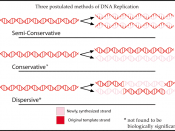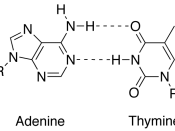DNA is usually a double-helix and has two strands running in opposite directions. Each chain is made of subunits called nucleotides.
Each strand has a backbone made up of deoxy-ribose sugar molecules (5 sugars) linked together by phosphate groups.
Each sugar molecule is covalently linked to one of four possible bases, Adenine, Guanine, Cytosine and Thymine. A and G are larger molecules (called purines) and C and T are smaller molecules (called pyrimidines). In the DNA, the two strands run in opposite directions and the bases pair up so that A always pairs with T and G always pairs with C. The A-T pair has 2 hydrogen bonds and the G-C pair has 3 hydrogen bonds. The G-C interaction is therefore stronger (by about 30%) than A-T.
DNA REPLICATION
DNA replicates, following the process of semiconservative replication. Each strand of the original molecule is separated and complemented with a new strand to bond with
The two strands of the double helix are first separated by the enzyme helicase, which attaches to the molecule and untwists and separates it.
With the assistance of enzyme polymerase, spare nucleotides available inside the cell are bound to the individual strands following the rules of complementary base pairing: adenine (A) to thymine (T) and guanine (G) to cytosine (C).
Two strands of DNA are obtained from one, having produced two daughter molecules which are identical to one another and to the parent molecule.
BIBLIOGRAPHY
http://www.pbs.org/wgbh/aso/databank/entries/do53dn.html
http://www.accessexcellence.org/AB/BC/Rosalind_Franklin.html
http://www.pbs.org/wgbh/aso/databank/entries/bofran.html
http://www.pbs.org/wgbh/aso/databank/entries/bofran.html
http://www.accessexcellence.org/AB/GG/dna_replicating.html


